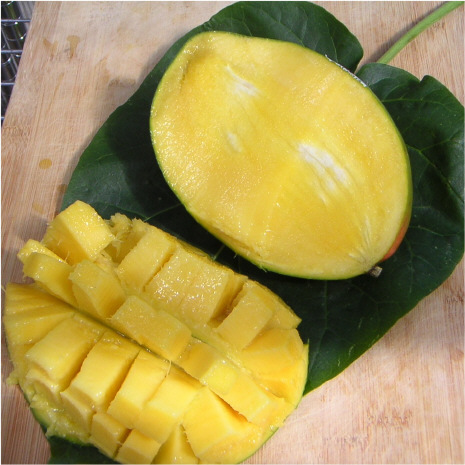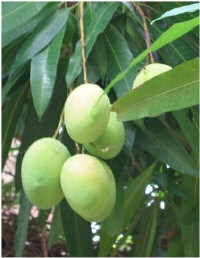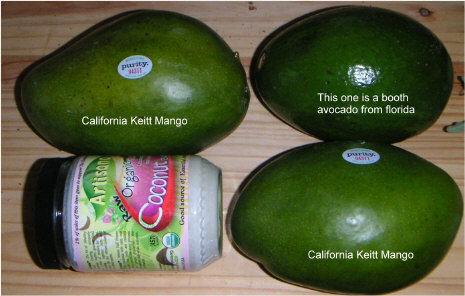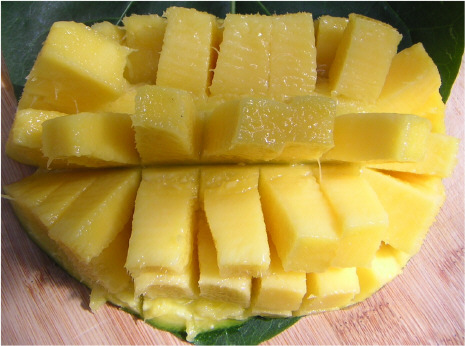My Favorite Mango -
The California Green Keitt Mango - Also known as my breakfast...
by John Kohler
October is here, and while many raw foodists are waving good-bye to
the fabulous summer fruits that just are out of season.. I will miss fond memories of
purple mulberry juice running down my chin and Indian red peach juice staining my teeth...
There are new "in-season" fruits that are just appearing.. persimmons, apples,
pears, grapes, and citrus soon to be here.. Although one really delicious in-season
fruit often overlooked: The Mango... The number one consumed fruit in the
world.
 Mangos have been
cultivated for over 4,000 years. Originally from Southeast Asia. They are grown in
sub-tropical and tropical regions of the world. Mango trees are evergreen
trees that grow 60 feet tall and produce fruit within 4-6 years. The Mango tree
belongs to the sumac family (Anacardiaceae). Which is the same family as
poison sumac and poison oak. This is why some people get a mouth rash from eating
mangoes. I usually like to wipe up any mango juice and sap immediately after eating,
and also avoid eating the peel. Mangos have been
cultivated for over 4,000 years. Originally from Southeast Asia. They are grown in
sub-tropical and tropical regions of the world. Mango trees are evergreen
trees that grow 60 feet tall and produce fruit within 4-6 years. The Mango tree
belongs to the sumac family (Anacardiaceae). Which is the same family as
poison sumac and poison oak. This is why some people get a mouth rash from eating
mangoes. I usually like to wipe up any mango juice and sap immediately after eating,
and also avoid eating the peel.
It is October in California, and we are in the middle of the
California-Grown Mango Season. Yes, mangoes do grow in some parts of
California! The region they are grown commercially is the Coachella Valley
which is just over 90 miles to the border of Mexico. In the desert-like conditions,
the Keitts were selected after trials of 50 varieties for commercial viability.
There are two major commercial growers of mangoes in California. The Keitt was
selected for its frost tolerance, although during the freeze last January, many small
trees were lost, although established trees suffered minimal damage. So yields were down
this year.
All Mangoes may not be raw!
Did you know that imported mangoes must be hot water treated and may
not be considered raw? Read the USDA APHIS hot water treatment guidelines.
Almost all imported mangoes must be hot water treated to kill pests
(fruit fly) which also is known to diminish the aroma, affect the flavor and cause a pasty
flesh as well as shriveling.. Yes.. They must hot water treat organic-imported
mangoes as well.
The guidelines state that hot water treatment is at a minimum of 115
F. degrees. Other sources online state that the temperature should be about 122
degrees F. Treatments can last for as long as 90 minutes!! Of course,
this is the external surface of the fruit, does the inside of the fruit really heat up
that much? I hope not. But at least be aware this is what is happening to all
imported mangoes.
See for yourself! On the outside of every imported mango box, there
will be a stamp USDA APHIS hot-water treatment stamp. Some people in the Raw Food
Movement no-longer consider mangoes "raw". Of course, I eat imported
mangoes, when that is the best food choice. (Of course, I would rather have home-grown,
farmers market grown, or local produce ) but sometimes during the winter, its the best you
can do! I do consider them raw, because the core temperature does get too hot in my
opinion, and they still do go bad.
Well, not to worry! California Mangoes have no-need for hot
water treatment, so they are raw. Better yet, many California mangoes have Organic
Certification! What better than that!
All about the California Keitt Mango
The Keitt mango is an Indian strain of the mango
thought to have originated from a seedling of Mulgoba mango variety grown in 1945 in
Homestead, Florida. The Keitt Mango is grown all over the world, including
Florida, Hawaii, Puerto Rico, Israel, Mexico, Australia and South Africa.
The California Keitt Mango is grown using organic and
non- organic methods. It is reported that when one of the growers got certified for
organic standards, they said their cost went up, since the weed control was more
expensive.. What does this probably mean? They spray chemicals to kill the
weeds between the trees in the orchard of the non-organic mangoes..
Here is a picture of the label codes on the California
mangoes, so you can distinguish them from "green" unripe mangoes:

Don't be scared to purchase one of these green.
Many people think produce that is green are not ripe. This is not always the case. With
the Keitt mango, they ARE RIPE WHEN GREEN! They turn from
orange-green to bright green when ripe. Since the California Keitt Mangoes are grown
in California, they can be left on the tree longer than imported mangoes, which provides a
sweeter, more mature mango.
The Keitt Mango is a virtually fiberless (less stringy) fruit, so it
has a really nice smooth texture. Ripe ones are ever so sweet and delicate tasting.
They are only available for a short 6 to 8 week time span during September
and October..
These are large fruit. They have been reported to weigh as much as 5
pounds. The largest Keitt Mango I purchased was over 2.5 pounds! That's one big
mango!

The flesh of the mango is golden-orange and the taste is quite
delicate, with a hint of lemon undertones and a smooth sweetness . The seed is a
small flat seed, which makes cutting the mango easy.
To date, this is my favorite mango on earth! (Although I have not
yet been to Southeast Asia, anyone want to go?)
Mango Nutrition
Of course, as with other fruits, mangoes are low in
calories and fat, but high in nutrients. Just 1 cup of mango contains 68% of the RDA
for Vitamin A and 80% for Vitamin C. Mangoes also contain potassium, vitamin B6 and
of course, fiber.
How to select a California Keitt Mango
Selecting a ripe California Mango can be tricky. For people
that have been to tropical locations and have picked ripe mangoes know what I mean.
Picking a unhot water treated mango is different than picking a hot water treated mango.
Most people are familiar with picking a ripe mango that has been
imported and hot water treated. Usually you need to pick one a bit more softer
than normal.
When picking a un-hot water treated mango, you need to ensure that
it is more firm than an equivalent hot water treated mango, otherwise you will have picked
one that is OVER RIPE! Trust me, I have done this on more than one occasion.
If you don't remember anything else in this article, remember this!
So you want to check ripeness like you would an avocado. Hold
the mango in the palm of your hand and give a gentle squeeze. Please don't bruise
the fruit! A ripe mango will give slightly and have an overall feeling of softness.
When they are ripe, store in the refrigerator and eat within a few days.
If they are not ripe, I like to store my mangoes and other fruits at room
temperature. I also like to smell my fruit and look for the clear
'sap' that sometimes drizzles out of the stem end.. for indicator of ripeness.
If you buy them hard, don't worry, just put the mango in a bag with
a banana or apple, and the ethylene gas will help to hasten the ripening process, and
usually within 3-4 days, you should have a ripe mango.

Availability and Cost
Last year, I was traveling in Baltimore, Maryland and found Organic
California Keitt Mangoes at the Whole Foods on Fleet Street on sale for 99 cents each.
Needless to say, California mangoes consisted of a large percentage of my diet that
trip. I was just out there this year, and there were no mangoes to be found.
Now back in California, I was surprised to see them available at my local health food
store. The price ranges from $1.69 to $3.49 depending on the size and the store
selling the mangoes. Organic ones were more towards $2.49 and up, and the
non-organic were $1.69. The average price is $2.49 each. In the Bay
Area the Keitt California mangoes can be found at Monterey Market and Berkeley Bowl,
both in Berkeley, California. In previous years, I have purchased them
from Whole Foods, Trader Joe's, Raley's. Ask for them at your local supermarket, as
"California Keitt Mangoes". Often times, they are sold or available under
the Melissa's Specialty produce brand.
John's Simple Sweet and Spicy Fresh
Mango Dressing
1 California Keitt Mango (Can use other variety too!)
3 Organic red bell peppers (Sometimes I use hothouse)
1 Ripe Cayenne Pepper - or other RIPE hot pepper!
Remove pulp from mango. Place in Vitamix or other
high power blender. De-seed and de-stem the bell pepper and place in blender.
De-seed, de-stem the cayenne pepper, and add 1/4 to 1/2 or the whole thing, depending on
how "hot" you like. Then blend on high to make the dressing. Sample and
add more hot pepper if its not hot enough for you. Its always better to start off
adding a little hot peppers, since you can always add more hot pepper later. If you
make it too hot to start, then you need to add more mango,and more red bell pepper to
dilute the hotness.
This dressing makes enough dressing for one or two.
(depends on how much dressing you like). Sometimes I like my salad to be swimming in
dressing!! So double this recipe if you like dressing!
Please note: Hot peppers should not be green, if they
are green, they are not ripe, and I do not advise using them. Hot peppers will
change color to a red, orange, yellow or other color when ripe.
Remember: Freshest is Bestest!
 About
the author, John Kohler has been on the
living and raw foods diet for over 12 years; he turned to living foods for healing from a
life threatening-illness (spinal meningitis) and has enjoyed dynamic health ever since.
One of Johns goals is to educate the world about the power of living and raw foods. He is
the founder and webmaster of the largest living and raw food website on the internet, www.living-foods.com, and www.rawfoodsupport.com.
John is also the number one expert on raw foods appliances and gadgets in the world.
He is widely sought out and regularly speaks and instructs at many raw food festivals and
events. His area of expertise include recipe demos with 5-7 ingredients or less, young
coconut recipes, traveling while raw, raw food appliances, successful transition to the
raw foods diet, and the importance of a fresh organic whole foods diet. He believes
that by using fresh, organic, and whole ingredients, that simple, healthy, and delicious
recipes can be made with few ingredients and without the use of salt, oil, spices, refined
sweeteners or chemical additives. He is known for his pragmatic approach to
raw foods and has coached and helped thousands of people to incorporate more fresh raw
fruits and vegetables into their diet. John
is also available to individual raw food coaching. About
the author, John Kohler has been on the
living and raw foods diet for over 12 years; he turned to living foods for healing from a
life threatening-illness (spinal meningitis) and has enjoyed dynamic health ever since.
One of Johns goals is to educate the world about the power of living and raw foods. He is
the founder and webmaster of the largest living and raw food website on the internet, www.living-foods.com, and www.rawfoodsupport.com.
John is also the number one expert on raw foods appliances and gadgets in the world.
He is widely sought out and regularly speaks and instructs at many raw food festivals and
events. His area of expertise include recipe demos with 5-7 ingredients or less, young
coconut recipes, traveling while raw, raw food appliances, successful transition to the
raw foods diet, and the importance of a fresh organic whole foods diet. He believes
that by using fresh, organic, and whole ingredients, that simple, healthy, and delicious
recipes can be made with few ingredients and without the use of salt, oil, spices, refined
sweeteners or chemical additives. He is known for his pragmatic approach to
raw foods and has coached and helped thousands of people to incorporate more fresh raw
fruits and vegetables into their diet. John
is also available to individual raw food coaching.
|
